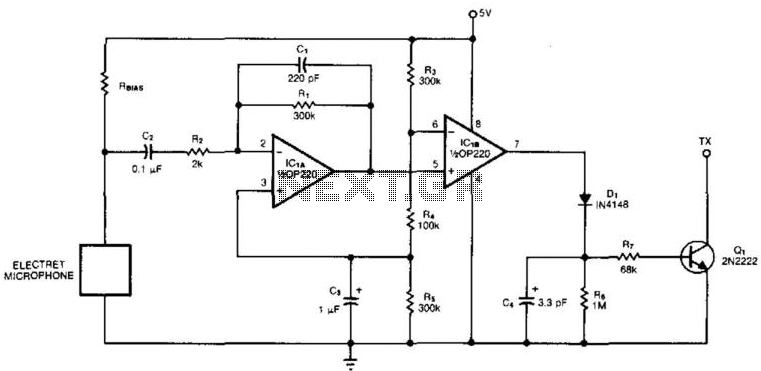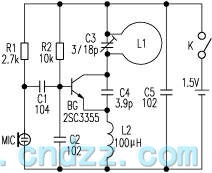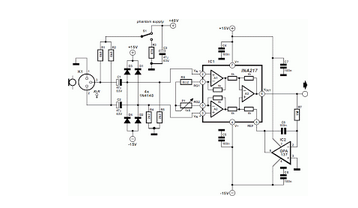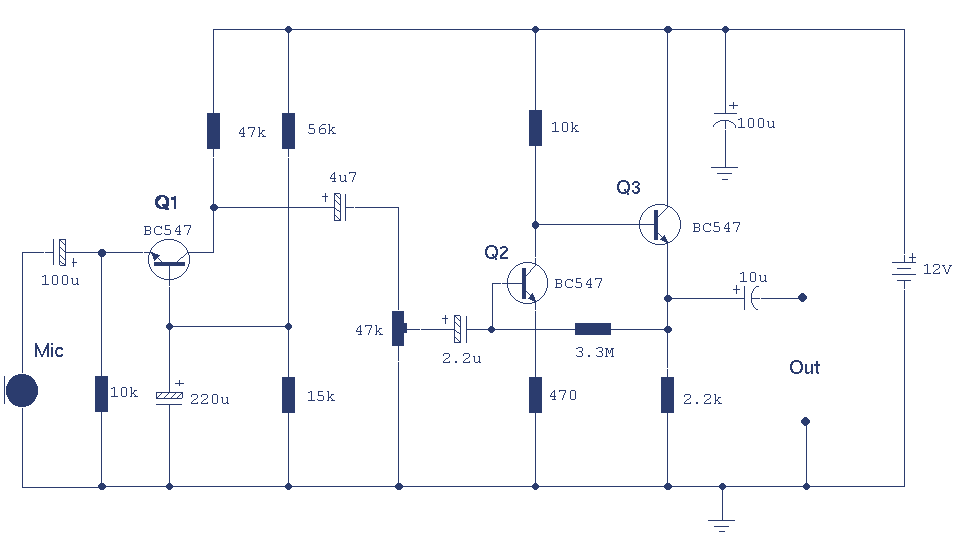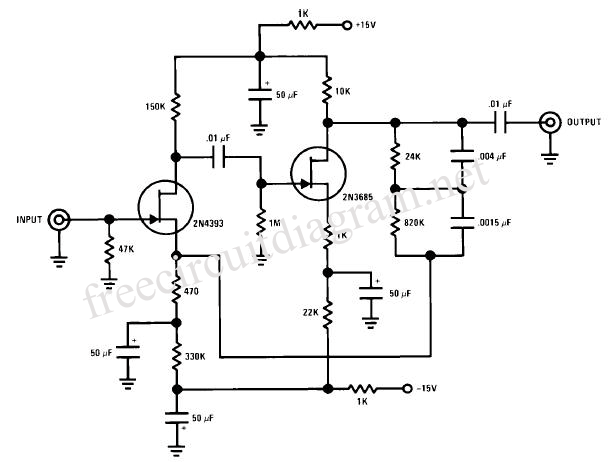
ECM microphone preamplifier
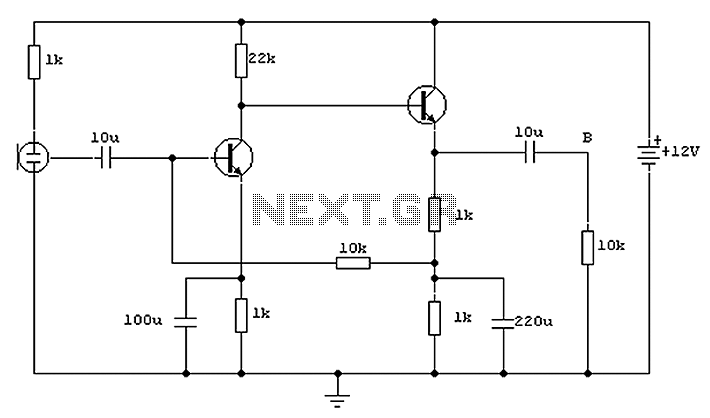
Both transistors utilized in the circuit are low-noise types. Initially, the BC650C, an ultra-low noise device, was employed. However, due to its scarcity, the BC109C serves as a suitable replacement. The circuit exhibits a high tolerance for various devices and establishes its quiescent point at approximately half the supply voltage at the emitter of the final transistor. The electret condenser microphone (ECM) features a highly sensitive microphone element along with an internal FET preamplifier, necessitating a power supply within the range of 2 to 10 volts DC. Compatible ECMs can be sourced from Maplin Electronics. A 1k ohm resistor is included to limit the current supplied to the microphone. The output impedance is notably low, making it ideal for driving cables over distances of up to 50 meters, thus eliminating the need for screened cables.
The circuit design incorporates two low-noise transistors, enhancing the overall performance and signal integrity of the audio system. The BC650C transistor, known for its ultra-low noise characteristics, was initially selected for its superior performance in audio applications. The BC109C, as a replacement, retains adequate low-noise performance while being more readily available. The configuration allows for flexibility in device selection without compromising the circuit's functionality.
The quiescent point, set at half the supply voltage, ensures that the final transistor operates efficiently, providing optimal amplification of the audio signal. This design consideration is critical for achieving a balanced output and minimizing distortion during signal processing.
The electret condenser microphone (ECM) plays a pivotal role in capturing sound. Its internal FET preamplifier amplifies the weak signals generated by the microphone element, making it suitable for low-voltage operation. A power supply of 2 to 10 volts DC is required to ensure proper functionality, which can be easily sourced from various power supplies available on the market.
The inclusion of a 1k ohm resistor serves to limit the current flowing to the microphone, protecting it from excessive current that could lead to damage. This resistor is a crucial component in maintaining the integrity of the microphone's operation.
The circuit's output characteristics are designed to accommodate long cable runs, with an output impedance that remains low. This feature allows for the use of standard cables over distances up to 50 meters without significant signal degradation, thus negating the necessity for screened cables. Overall, this circuit design exemplifies an efficient and effective approach to audio signal amplification, ensuring high-quality performance in various applications. Both transistors are low noise types. In the original circuit, I used BC650C which is an ultra low noise device. These transistors are now hard to find but BC109C are a good re placement. The circuit is very device tolerant and will set its quiescent point at roughly half the supply voltage at the emitter of the last transistor.The electret condenser microphone (ECM) contains a very sensitive microphone element and an internal FET preamp, a power supply in the range 2 to 10 volts DC is therefore necessary. Suitable ECMs may be obtained from Maplin Electronics. The 1k resistor limits the current to the mic. The output impedance is very low and well suited to driving cables over distances up to 50 meters. Screened cable therefore is not necessary.
The circuit design incorporates two low-noise transistors, enhancing the overall performance and signal integrity of the audio system. The BC650C transistor, known for its ultra-low noise characteristics, was initially selected for its superior performance in audio applications. The BC109C, as a replacement, retains adequate low-noise performance while being more readily available. The configuration allows for flexibility in device selection without compromising the circuit's functionality.
The quiescent point, set at half the supply voltage, ensures that the final transistor operates efficiently, providing optimal amplification of the audio signal. This design consideration is critical for achieving a balanced output and minimizing distortion during signal processing.
The electret condenser microphone (ECM) plays a pivotal role in capturing sound. Its internal FET preamplifier amplifies the weak signals generated by the microphone element, making it suitable for low-voltage operation. A power supply of 2 to 10 volts DC is required to ensure proper functionality, which can be easily sourced from various power supplies available on the market.
The inclusion of a 1k ohm resistor serves to limit the current flowing to the microphone, protecting it from excessive current that could lead to damage. This resistor is a crucial component in maintaining the integrity of the microphone's operation.
The circuit's output characteristics are designed to accommodate long cable runs, with an output impedance that remains low. This feature allows for the use of standard cables over distances up to 50 meters without significant signal degradation, thus negating the necessity for screened cables. Overall, this circuit design exemplifies an efficient and effective approach to audio signal amplification, ensuring high-quality performance in various applications. Both transistors are low noise types. In the original circuit, I used BC650C which is an ultra low noise device. These transistors are now hard to find but BC109C are a good re placement. The circuit is very device tolerant and will set its quiescent point at roughly half the supply voltage at the emitter of the last transistor.The electret condenser microphone (ECM) contains a very sensitive microphone element and an internal FET preamp, a power supply in the range 2 to 10 volts DC is therefore necessary. Suitable ECMs may be obtained from Maplin Electronics. The 1k resistor limits the current to the mic. The output impedance is very low and well suited to driving cables over distances up to 50 meters. Screened cable therefore is not necessary.
